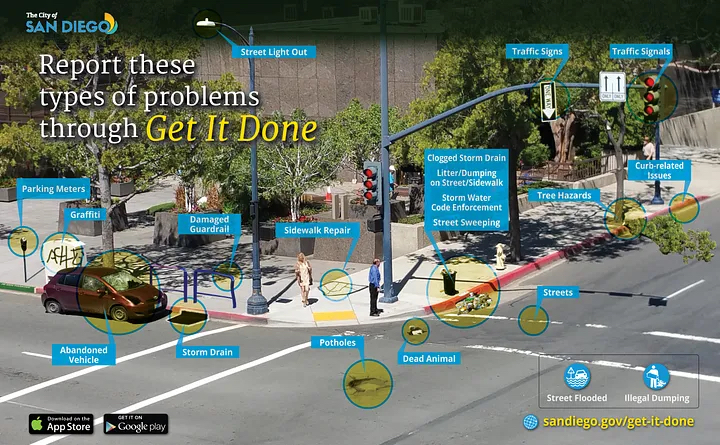San Diego, California, USA
San Diego: Customizing its Own Portal and Building a Smart City.
Project Type:
Community Engagement, Environment, High-Performing Government, Infrastructure, Technology, Transportation

San Diego most recently achieved 2024 Silver What Works Cities Certification. The following narrative was written for San Diego’s 2020 Silver What Works Cities Certification. Some content may be outdated. For the most current information, please visit sandiego.gov.
At a Glance
Utilized an open source code to automate the publication of data sets to staff and residents in real time, saving time, resources, and reducing the potential for human error.
Created an app to allow residents to more efficiently report complaints and track progress by the response crews.
Relied on data to prioritize road repairs and how to time them with other infrastructure improvements, such as replacing water or sewer lines, to maximize efficiency.
Making Data Transparent
The City of San Diego has its own way of getting things done. While many of the cities leading the way in data-driven governance have been at this work for years, San Diego was a late bloomer. Most of the City’s open data efforts began in 2014, as Mayor Kevin Faulconer was taking office. Since then, Mayor Faulconer has created a Performance & Analytics Department, and the work has taken off. The City passed an open data policy and, soon after, hired Chief Data Officer Maksim Pecherskiy to begin implementing it.
After coming on board, Pecherskiy’s first order of business was to launch the City’s open data portal, and thanks to his background in programming, he brought a fresh perspective to the task. After reviewing several vendor options, he found that none allowed him to realize his vision. So, he set out to build his own, basing it on an open source project developed in Philadelphia. The portal, which only costs the City around $7 a month to host, launched with an initial 44 data sets voted on by the public for priority release.
Pecherskiy has also leaned on open source code to automate the publication of data sets to the portal. Most cities, he explains, have to publish data sets internally and then externally via distinct processes that can consume between 10 and 20 staff hours per month. But Pecherskiy has made it so that any public data sets automatically publish in both locations, saving time as well as reducing the potential for human error. Staff receive daily email digests with the most updated data, and residents gain access to new data sets nearly in real time. Pecherskiy says there’s also the potential to tie the automation to performance by triggering emails to management when data falls below a certain level.
San Diego also took an unconventional approach to starting its 311 program. The City has never had a designated call center for complaints, so residents often resorted to calling 911 or a non-emergency police number, but the latter was also answered by emergency operators. A resident satisfaction survey showed that 80% of San Diegans didn’t even want to make phone calls to report problems, so the City bypassed the traditional 311 model altogether and went straight to launching its Get It Done app. “We didn’t want to create a new call center that would likely become obsolete in the near future just because that’s how cities have always done it,” says Almis Udrys, Deputy Chief of Staff for Innovation & Policy.

Using Get It Done, residents can now report and track progress on a variety of complaints directly from their mobile phones, and response crews are closing the loop by sending “after” photos to residents, who can rate their experience with a thumbs up, thumbs down, or a comment. The app is helping the City become more efficient, too. Before the launch, paperwork for a resolved complaint might sit on a desk for weeks before being reflected in the data, meaning departments couldn’t track how quickly they were responding to issues. Get It Done data is also helping the City in other ways, such as identifying sanitation hazards while partnering with the County to address a recent outbreak of hepatitis A.
The City has applied its newfound data prowess to Mayor Faulconer’s doubled investment in road repairs and ambitious goal to fix 1,000 miles of road by 2020. “I think infrastructure is the ticking time bomb in most cities today,” says Udrys. “Our mayor is really getting out ahead of the problem.” By using data to prioritize repairs and time them with other infrastructure improvements, such as replacing water or sewer lines, the City is ahead of target, and residents can see the progress for themselves on the StreetsSDportal.

Across the City, the world’s largest Internet of Things platform is being rolled out through the installation of street lamps equipped with “smart” technology, part of a partnership with General Electric. Staff can monitor outages and adjust the brightness of the lights remotely, at the same time that sensors in the lamps are providing invaluable data. By monitoring pollution levels, the lamps can help the City better advance its Climate Action Plan, which calls for eliminating half of all greenhouse gas emissions in the City and aims for all electricity used in the city to be from renewable sources by 2035. The sensors will also help the City more effectively monitor parking spot usage, traffic patterns, pedestrian safety, and more.

Deputy Chief Operating Officer David Graham recently recalled seeing a young couple and their children among attendees at a demonstration of the lamps. When he asked what inspired them to come, their answer was simple: they wanted their son to be safe if they allowed him to walk to school, and data would go a long way in helping them make the choice.
“We didn’t just want to dump data out there; we wanted to put it out there in formats that people could actually utilize. The data belongs to the people, so they should be able to access it.”